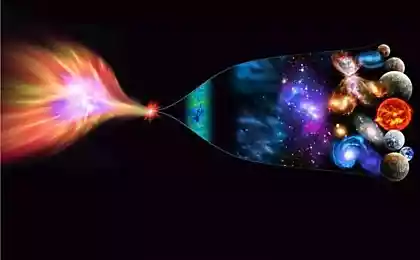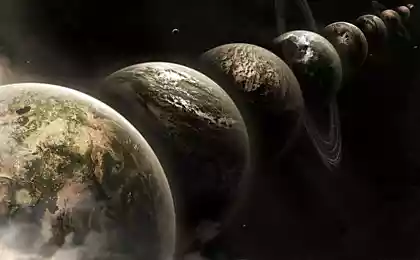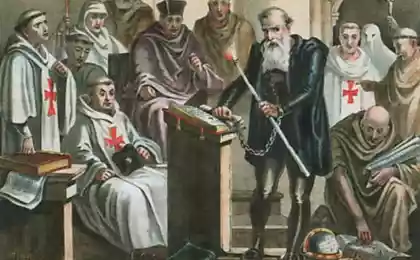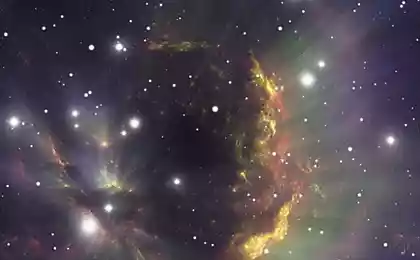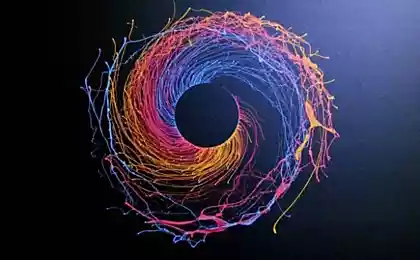721
Competitor the Big Bang theory. That was a zillion years ago
The title of this article may not seem too clever joke. According to the generally accepted cosmological concept of the Big Bang theory, our universe emerged from extreme States of physical vacuum, generated by quantum fluctuation. In this state there was neither the time nor the space (or they were tangled in the space-time foam), and all fundamental physical interactions were merged. Later they separated and acquired an independent existence — first gravity, then the strong interaction, weak and electromagnetic.
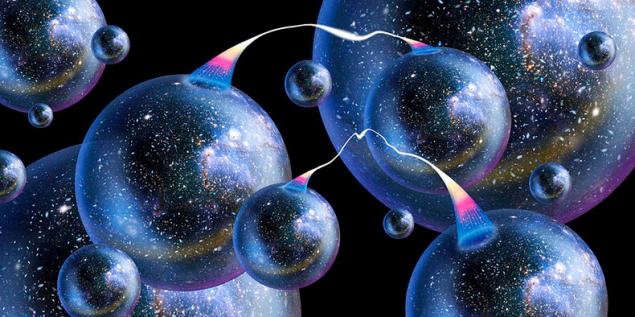
The Big Bang theory enjoys the confidence of the absolute majority of scholars studying the early history of our Universe. It really explains a lot and in no way contradicts the experimental data.
However, recently she had a competitor in the face of a new cyclic theory, which has developed two physics-class — Director of the Institute for theoretical science at Princeton University Paul Steinhardt and winner of the Maxwell medal and the prestigious international award TED Neil Turok, Director of the canadian Institute for advanced research in theoretical physics (Perimeter Institute for Theoretical Physics). With the help of Professor Steinhardt "Popular mechanics" tried to tell you about cyclical theory and the reasons for its occurrence.
The time that preceded the event, when there was a "first gravity, then the strong interaction, weak and electromagnetic.", be designated as zero time, t=0, but this is pure Convention, a tribute to the mathematical formalism. According to standard theory, continuous time began only after the force of gravity gained independence.
This point is usually credited with the value t=10-43 s (more precisely, 5,4x10-44), which is called the Planck time. Modern physical theory is simply not able to consciously work with shorter periods of time (it is believed that this requires a quantum theory of gravity that does not yet exist). In the context of traditional cosmology makes no sense to talk about what happened before the start time, since time in our understanding simply did not exist.

An indispensable part of the standard cosmological theory, the concept of inflation. After the end of inflation came into its own gravity, and the universe continued to expand, but at a decreasing rate.
This evolution lasted for 9 billion years, after which it came into another anti-gravity field, still of unknown nature, called dark energy. It again brought the Universe in the regime of exponential expansion, which seems to be should persist in the future. It should be noted that these conclusions are based on astrophysical discoveries made in the last century, almost 20 years after the advent of inflationary cosmology.
The first interpretation of the inflationary Big Bang was proposed about 30 years ago and since then repeatedly polished. This theory helped to solve some fundamental problems that failed the earlier cosmology.
For example, she explained why we live in a Universe with Euclidean flat geometry in accordance with the classical equations of Friedman, and that's what she needs to do with the exponential expansion.
Theory of inflation explains why the cosmic matter has a grain size on a scale exceeding hundreds of millions of light years, and at large distances evenly distributed. She also gave an interpretation of the failure of any attempts to detect magnetic monopoles are very massive particles with a single magnetic pole, which are believed to be in abundance were born before the beginning of inflation (so inflation stretched space that the original high density of monopoles was reduced to almost zero, and hence, our instruments are unable to detect them).
Shortly after the appearance of the inflationary model some theorists realized that its internal logic is not antithetical to the idea of a permanent multiple birth new universes. In fact, quantum fluctuations, similar to those which we owe the existence of our world, can occur in any number, if the conditions are right.
It is not excluded that our universe came from a fluctuation zone, formed in the world-the predecessor. Similarly, we can assume that sometime and somewhere in our own Universe formed fluctuation, which "blow" the young universe is quite another kind is also capable of cosmological "conceive." There are models in which such child universes arise continuously, pull away from their parents and find their own place. This does not necessarily that such worlds are set the same physical laws.
All these worlds are "invested" in a single space-time continuum, but posted it so that he could not feel the presence of each other. In General, the concept of inflation allows — indeed forces! to think that in a gigantic magicsmoke there are many isolated from each other universes with different device.
Theoretical physicists love to come up with alternatives even the most generally accepted theories. New competitors and the inflationary model of the Big Bang. They do not have widespread support, but had and have his followers. The theory of Steinhardt and Turok among them not the first and certainly not the last. To date, however, she developed other more detailed and better explanation of the observed properties of our world. It has several versions, some of which are based on the theory of quantum strings and multidimensional spaces, while others rely on traditional quantum field theory. The first approach gives a more clear picture of cosmological processes, so that it will stop.
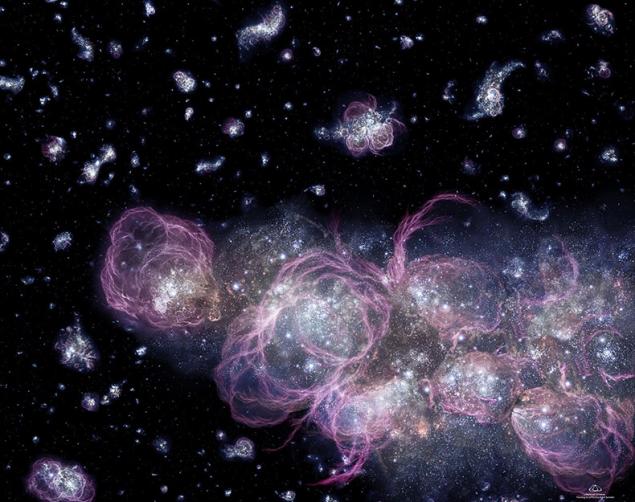
Most advanced version of string theory known as M-theory. She argues that the physical world has 11 dimensions, ten spatial and one temporal. In this floating space of smaller dimension, called branes.
Our universe is just one such brane, with three spatial dimensions. It is filled with various quantum particles (electrons, quarks, photons, etc.) that really are open vibrating strings with only one spatial dimension — length. The ends of each string tightly fixed inside a three-dimensional brane, and leave bran's string can not. But there are also closed strings, which can migrate outside bran is the gravitons, the quanta of the gravitational field.
As the cyclic theory explains the past and future of the universe? Let's start with the current era. First place now belongs to the dark energy that causes our Universe to expand exponentially, periodically doubling the size. As a result, the density of matter and radiation is decreasing, the gravitational curvature of space weakens, its geometry becomes more flat.
Over the next trillion years, the size of the Universe is doubled about a hundred times and it will turn into a almost empty world, totally devoid of material structures. Next to us is another three-dimensional brane, separated from us by a tiny distance in the fourth dimension, and it also undergoes the same exponential stretching and flattening. All this time, the distance between the branes does not change.
And then these parallel branes begin to converge. Pushes them towards each other the force field, the energy of which depends on the distance between branes. Now the energy density of this field is positive, so the space of both brane expands exponentially, it follows that it is this field and provides effect which explain the presence of dark energy!
However, this parameter gradually decreases and after trillions of years will fall to zero. Both branes will still continue to grow, but not exponentially, but at a very slow pace. Therefore, in our world, the density of particles and radiation will remain almost zero and the geometry is flat.
But the end of old story is only a prelude to the next cycle. The branes move towards each other and eventually collide. At this stage the energy density miranova field drops below zero, and it begins to act like gravity (recall that gravitational potential energy is negative!).
When the branes are very close, miranova field begins to enhance quantum fluctuations at every point of our world and converts them into macroscopic deformation of the spatial geometry (for example, in one millionth of a second before the collision, the estimated size of such deformations up to several meters). After the collision it is in these zones is allocated the lion's share is released upon impact of the kinetic energy. In the end, there arises more of hot plasma with a temperature of about 1023 degrees. These areas become the local nodes of gravitation and become the embryos of future galaxies.
Such a collision replaces the Big Bang inflationary cosmology. It is very important that all newly arising matter with positive energy appears due to the accumulated negative energy miranova field, so the law of conservation of energy is not violated.
And how such a field behaves at this crucial time? Before collision the density of its energy reaches a minimum (and negative), and then begins to increase, and the collision becomes zero. Then, the branes repel each other and begin to disperse. Density miranova energy is the opposite of evolution — again, is negative, zero, positive.
Enriched with matter and radiation Branagh first expands with the falling speed under the braking influence of its own gravitation, and then reverts to an exponential expansion. New cycle comes to an end like former — and so on to infinity. The cycles preceding ours, has done in the past — in this model, time is continuous, therefore, the past exists and is outside the 13.7 billion years since the last enrichment of our brane with matter and radiation! Whether they have a start, the theory is silent.
Cyclical theory in the new explains the properties of our world. It has a flat geometry, because by the end of each cycle excessively stretched and deformed only slightly before beginning a new cycle. Quantum fluctuations, which become the precursors of galaxies occur randomly, but on average evenly — so the space is filled with clumps of matter, but at very large distances is quite homogeneous. We can't detect magnetic monopoles simply because the maximum temperature of the newborn plasma did not exceed 1023 K, and for the occurrence of such particles need much more energy is of the order of 1027 K.
Cyclic theory exists in several versions, like the theory of inflation. However, according to Paul Steinhardt, the differences between them are purely technical and of interest only to specialists, the overall concept remains the same: "first, in our theory there is no beginning of the world, no singularity.
There are periodic phases of intense birth of matter and radiation, each of which is optionally call the Big Bang. But any of these stages marks the emergence of a new universe, but merely a transition from one cycle to another. And space and time exist before and after any of these disasters. It is therefore quite natural to ask, what was the situation for 10 billion years before the last Big Bang, which counts the history of the universe.
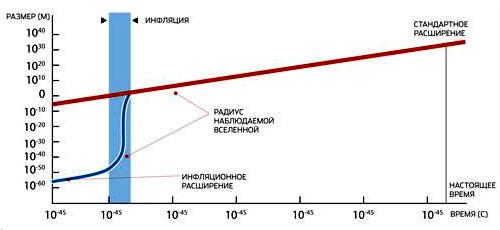
The second key difference is the nature and role of dark energy. Inflationary cosmology predicted the transition decelerating expansion of the Universe accelerated. But when astrophysicists have discovered this phenomenon, watching the flashes of distant supernovas, the standard cosmology didn't even know what to do with it. The hypothesis of dark energy was put forward simply to somehow tie to the theory of the paradoxical results of these observations.
But our approach is much better bonded to the internal logic, since dark energy we have present initially and that it ensures the alternation of cosmological cycles." However, as noted by Paul Steinhardt have a cyclic theory and weaknesses: "We have not yet managed to convincingly describe the process of collision and rebound of parallel branes that occur at the beginning of each cycle. Other aspects of cyclic theory is developed much better, and it will eliminate a lot of uncertainties".
But even the most beautiful theoretical models need experimental verification. Is it possible to confirm or refute a cyclic cosmology using observations? "Both theory and the inflationary and cyclic, predict the existence of relic gravitational waves, explains Paul Steinhardt. — In the first case, they arise from the initial quantum fluctuations during inflation are smeared out in space and give rise to periodic variations in its geometry — and that, according to the General theory of relativity, and there are waves of gravity.
In our scenario, the root cause of such waves are also quantum fluctuations — those that increase in the collision of branes. Calculations showed that each mechanism generates a wave with a specific range and a specific polarization. These waves have been obliged to leave imprints on cosmic microwave radiation, which serves as an invaluable source of information about the early cosmos.
While such traces could not be found, but most likely this will be done in the next decade. In addition, physicists are already thinking about direct registration of relic gravitational waves using the spacecraft that appear in two or three decades".
Another difference, according to Professor Steinhardt is the temperature distribution of microwave background radiation: "the radiation coming from different parts of the sky, not quite uniform in temperature, there are more and less heated areas. On the level of measurement accuracy, which provides modern equipment, the number of hot and cold zones about the same, which is consistent with the findings of both theories and of the inflationary and cyclic.
However, these theories predict more subtle differences between the zones. In principle, they will be able to identify launched last year, the European space Observatory 'plank' and other advanced spacecraft. I hope that the results of these experiments will help to make a choice between inflation and cyclical theories. But it may happen that the situation will remain uncertain and none of the theories do not get unambiguous experimental support. Well, then you have to come up with something new."
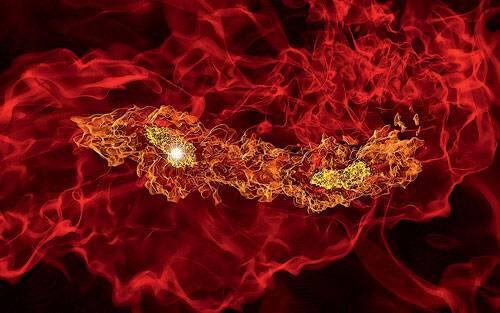
According to the inflationary model, the universe soon after its birth a very short time exponentially expanded, repeatedly doubling its linear dimensions. Scientists believe that the beginning of this process coincided with the separation of the strong interaction happened on the timestamp at 10-36 s.
Such an extension (with a light hand American theoretical physicist Sidney Coleman it became known as cosmological inflation) was extremely short (up to 10-34 s), but increasing the linear size of the Universe at least in 1030 1050 times, and it is possible that a lot more. In accordance with the most specific scenarios, inflation launched antigravity quantum scalar field energy density which is gradually decreased and eventually reached a minimum.
Before this happened, the field quickly began to oscillate, giving rise to elementary particles. As a result, by the end of the inflationary phase the universe was filled with superhot plasma, consisting of free quarks, gluons, leptons and high-energy quanta of electromagnetic radiation.
A radical alternative
1980-ies Professor Steinhardt has made a considerable contribution to the development of the standard theory of the Big Bang. However, this did not prevent him to seek a radical alternative theory, which invested so much work. As told Popular mechanics he Paul Steinhardt, the hypothesis of inflation does open many cosmological riddles, but this does not mean that there is no point in looking for other explanations: "First, I was just curious to try to understand the basic properties of our world without resorting to inflation.
Later, when I delved into this issue, I was convinced that the inflation theory is not as perfect as its proponents claim. When inflationary cosmology was created, we were hoping that she would explain the transition from the initial chaotic state of matter to the current orderly Universe. She did — but went a lot further.
The internal logic of the theory required to recognize that inflation is constantly doing an infinite number of worlds. This would have been okay if their physical device copied our own, but this just does not work. Here, for example, using the inflationary hypothesis was able to explain why we live in a Euclidean world, but most other universes obviously would not have the same geometry.
Free electricity for all and 4 the forgotten inventions
10 most bizarre biological discoveries of 2016
In short, we have built a theory to explain his own world, and she is out of control and spawned an endless variety of exotic worlds. This situation turned out to be unsatisfactory. Moreover, the standard theory cannot explain the nature to an earlier state prior esponenziale expansion. In this sense, it is as incomplete as diplacina cosmology. Finally, she is unable to say anything about the nature of dark energy, which is already 5 billion years governs the expansion of our Universe".published
Source: masterok.livejournal.com/3312127.html

The Big Bang theory enjoys the confidence of the absolute majority of scholars studying the early history of our Universe. It really explains a lot and in no way contradicts the experimental data.
However, recently she had a competitor in the face of a new cyclic theory, which has developed two physics-class — Director of the Institute for theoretical science at Princeton University Paul Steinhardt and winner of the Maxwell medal and the prestigious international award TED Neil Turok, Director of the canadian Institute for advanced research in theoretical physics (Perimeter Institute for Theoretical Physics). With the help of Professor Steinhardt "Popular mechanics" tried to tell you about cyclical theory and the reasons for its occurrence.
The time that preceded the event, when there was a "first gravity, then the strong interaction, weak and electromagnetic.", be designated as zero time, t=0, but this is pure Convention, a tribute to the mathematical formalism. According to standard theory, continuous time began only after the force of gravity gained independence.
This point is usually credited with the value t=10-43 s (more precisely, 5,4x10-44), which is called the Planck time. Modern physical theory is simply not able to consciously work with shorter periods of time (it is believed that this requires a quantum theory of gravity that does not yet exist). In the context of traditional cosmology makes no sense to talk about what happened before the start time, since time in our understanding simply did not exist.

An indispensable part of the standard cosmological theory, the concept of inflation. After the end of inflation came into its own gravity, and the universe continued to expand, but at a decreasing rate.
This evolution lasted for 9 billion years, after which it came into another anti-gravity field, still of unknown nature, called dark energy. It again brought the Universe in the regime of exponential expansion, which seems to be should persist in the future. It should be noted that these conclusions are based on astrophysical discoveries made in the last century, almost 20 years after the advent of inflationary cosmology.
The first interpretation of the inflationary Big Bang was proposed about 30 years ago and since then repeatedly polished. This theory helped to solve some fundamental problems that failed the earlier cosmology.
For example, she explained why we live in a Universe with Euclidean flat geometry in accordance with the classical equations of Friedman, and that's what she needs to do with the exponential expansion.
Theory of inflation explains why the cosmic matter has a grain size on a scale exceeding hundreds of millions of light years, and at large distances evenly distributed. She also gave an interpretation of the failure of any attempts to detect magnetic monopoles are very massive particles with a single magnetic pole, which are believed to be in abundance were born before the beginning of inflation (so inflation stretched space that the original high density of monopoles was reduced to almost zero, and hence, our instruments are unable to detect them).
Shortly after the appearance of the inflationary model some theorists realized that its internal logic is not antithetical to the idea of a permanent multiple birth new universes. In fact, quantum fluctuations, similar to those which we owe the existence of our world, can occur in any number, if the conditions are right.
It is not excluded that our universe came from a fluctuation zone, formed in the world-the predecessor. Similarly, we can assume that sometime and somewhere in our own Universe formed fluctuation, which "blow" the young universe is quite another kind is also capable of cosmological "conceive." There are models in which such child universes arise continuously, pull away from their parents and find their own place. This does not necessarily that such worlds are set the same physical laws.
All these worlds are "invested" in a single space-time continuum, but posted it so that he could not feel the presence of each other. In General, the concept of inflation allows — indeed forces! to think that in a gigantic magicsmoke there are many isolated from each other universes with different device.
Theoretical physicists love to come up with alternatives even the most generally accepted theories. New competitors and the inflationary model of the Big Bang. They do not have widespread support, but had and have his followers. The theory of Steinhardt and Turok among them not the first and certainly not the last. To date, however, she developed other more detailed and better explanation of the observed properties of our world. It has several versions, some of which are based on the theory of quantum strings and multidimensional spaces, while others rely on traditional quantum field theory. The first approach gives a more clear picture of cosmological processes, so that it will stop.

Most advanced version of string theory known as M-theory. She argues that the physical world has 11 dimensions, ten spatial and one temporal. In this floating space of smaller dimension, called branes.
Our universe is just one such brane, with three spatial dimensions. It is filled with various quantum particles (electrons, quarks, photons, etc.) that really are open vibrating strings with only one spatial dimension — length. The ends of each string tightly fixed inside a three-dimensional brane, and leave bran's string can not. But there are also closed strings, which can migrate outside bran is the gravitons, the quanta of the gravitational field.
As the cyclic theory explains the past and future of the universe? Let's start with the current era. First place now belongs to the dark energy that causes our Universe to expand exponentially, periodically doubling the size. As a result, the density of matter and radiation is decreasing, the gravitational curvature of space weakens, its geometry becomes more flat.
Over the next trillion years, the size of the Universe is doubled about a hundred times and it will turn into a almost empty world, totally devoid of material structures. Next to us is another three-dimensional brane, separated from us by a tiny distance in the fourth dimension, and it also undergoes the same exponential stretching and flattening. All this time, the distance between the branes does not change.
And then these parallel branes begin to converge. Pushes them towards each other the force field, the energy of which depends on the distance between branes. Now the energy density of this field is positive, so the space of both brane expands exponentially, it follows that it is this field and provides effect which explain the presence of dark energy!
However, this parameter gradually decreases and after trillions of years will fall to zero. Both branes will still continue to grow, but not exponentially, but at a very slow pace. Therefore, in our world, the density of particles and radiation will remain almost zero and the geometry is flat.
But the end of old story is only a prelude to the next cycle. The branes move towards each other and eventually collide. At this stage the energy density miranova field drops below zero, and it begins to act like gravity (recall that gravitational potential energy is negative!).
When the branes are very close, miranova field begins to enhance quantum fluctuations at every point of our world and converts them into macroscopic deformation of the spatial geometry (for example, in one millionth of a second before the collision, the estimated size of such deformations up to several meters). After the collision it is in these zones is allocated the lion's share is released upon impact of the kinetic energy. In the end, there arises more of hot plasma with a temperature of about 1023 degrees. These areas become the local nodes of gravitation and become the embryos of future galaxies.
Such a collision replaces the Big Bang inflationary cosmology. It is very important that all newly arising matter with positive energy appears due to the accumulated negative energy miranova field, so the law of conservation of energy is not violated.
And how such a field behaves at this crucial time? Before collision the density of its energy reaches a minimum (and negative), and then begins to increase, and the collision becomes zero. Then, the branes repel each other and begin to disperse. Density miranova energy is the opposite of evolution — again, is negative, zero, positive.
Enriched with matter and radiation Branagh first expands with the falling speed under the braking influence of its own gravitation, and then reverts to an exponential expansion. New cycle comes to an end like former — and so on to infinity. The cycles preceding ours, has done in the past — in this model, time is continuous, therefore, the past exists and is outside the 13.7 billion years since the last enrichment of our brane with matter and radiation! Whether they have a start, the theory is silent.
Cyclical theory in the new explains the properties of our world. It has a flat geometry, because by the end of each cycle excessively stretched and deformed only slightly before beginning a new cycle. Quantum fluctuations, which become the precursors of galaxies occur randomly, but on average evenly — so the space is filled with clumps of matter, but at very large distances is quite homogeneous. We can't detect magnetic monopoles simply because the maximum temperature of the newborn plasma did not exceed 1023 K, and for the occurrence of such particles need much more energy is of the order of 1027 K.
Cyclic theory exists in several versions, like the theory of inflation. However, according to Paul Steinhardt, the differences between them are purely technical and of interest only to specialists, the overall concept remains the same: "first, in our theory there is no beginning of the world, no singularity.
There are periodic phases of intense birth of matter and radiation, each of which is optionally call the Big Bang. But any of these stages marks the emergence of a new universe, but merely a transition from one cycle to another. And space and time exist before and after any of these disasters. It is therefore quite natural to ask, what was the situation for 10 billion years before the last Big Bang, which counts the history of the universe.

The second key difference is the nature and role of dark energy. Inflationary cosmology predicted the transition decelerating expansion of the Universe accelerated. But when astrophysicists have discovered this phenomenon, watching the flashes of distant supernovas, the standard cosmology didn't even know what to do with it. The hypothesis of dark energy was put forward simply to somehow tie to the theory of the paradoxical results of these observations.
But our approach is much better bonded to the internal logic, since dark energy we have present initially and that it ensures the alternation of cosmological cycles." However, as noted by Paul Steinhardt have a cyclic theory and weaknesses: "We have not yet managed to convincingly describe the process of collision and rebound of parallel branes that occur at the beginning of each cycle. Other aspects of cyclic theory is developed much better, and it will eliminate a lot of uncertainties".
But even the most beautiful theoretical models need experimental verification. Is it possible to confirm or refute a cyclic cosmology using observations? "Both theory and the inflationary and cyclic, predict the existence of relic gravitational waves, explains Paul Steinhardt. — In the first case, they arise from the initial quantum fluctuations during inflation are smeared out in space and give rise to periodic variations in its geometry — and that, according to the General theory of relativity, and there are waves of gravity.
In our scenario, the root cause of such waves are also quantum fluctuations — those that increase in the collision of branes. Calculations showed that each mechanism generates a wave with a specific range and a specific polarization. These waves have been obliged to leave imprints on cosmic microwave radiation, which serves as an invaluable source of information about the early cosmos.
While such traces could not be found, but most likely this will be done in the next decade. In addition, physicists are already thinking about direct registration of relic gravitational waves using the spacecraft that appear in two or three decades".
Another difference, according to Professor Steinhardt is the temperature distribution of microwave background radiation: "the radiation coming from different parts of the sky, not quite uniform in temperature, there are more and less heated areas. On the level of measurement accuracy, which provides modern equipment, the number of hot and cold zones about the same, which is consistent with the findings of both theories and of the inflationary and cyclic.
However, these theories predict more subtle differences between the zones. In principle, they will be able to identify launched last year, the European space Observatory 'plank' and other advanced spacecraft. I hope that the results of these experiments will help to make a choice between inflation and cyclical theories. But it may happen that the situation will remain uncertain and none of the theories do not get unambiguous experimental support. Well, then you have to come up with something new."

According to the inflationary model, the universe soon after its birth a very short time exponentially expanded, repeatedly doubling its linear dimensions. Scientists believe that the beginning of this process coincided with the separation of the strong interaction happened on the timestamp at 10-36 s.
Such an extension (with a light hand American theoretical physicist Sidney Coleman it became known as cosmological inflation) was extremely short (up to 10-34 s), but increasing the linear size of the Universe at least in 1030 1050 times, and it is possible that a lot more. In accordance with the most specific scenarios, inflation launched antigravity quantum scalar field energy density which is gradually decreased and eventually reached a minimum.
Before this happened, the field quickly began to oscillate, giving rise to elementary particles. As a result, by the end of the inflationary phase the universe was filled with superhot plasma, consisting of free quarks, gluons, leptons and high-energy quanta of electromagnetic radiation.
A radical alternative
1980-ies Professor Steinhardt has made a considerable contribution to the development of the standard theory of the Big Bang. However, this did not prevent him to seek a radical alternative theory, which invested so much work. As told Popular mechanics he Paul Steinhardt, the hypothesis of inflation does open many cosmological riddles, but this does not mean that there is no point in looking for other explanations: "First, I was just curious to try to understand the basic properties of our world without resorting to inflation.
Later, when I delved into this issue, I was convinced that the inflation theory is not as perfect as its proponents claim. When inflationary cosmology was created, we were hoping that she would explain the transition from the initial chaotic state of matter to the current orderly Universe. She did — but went a lot further.
The internal logic of the theory required to recognize that inflation is constantly doing an infinite number of worlds. This would have been okay if their physical device copied our own, but this just does not work. Here, for example, using the inflationary hypothesis was able to explain why we live in a Euclidean world, but most other universes obviously would not have the same geometry.
Free electricity for all and 4 the forgotten inventions
10 most bizarre biological discoveries of 2016
In short, we have built a theory to explain his own world, and she is out of control and spawned an endless variety of exotic worlds. This situation turned out to be unsatisfactory. Moreover, the standard theory cannot explain the nature to an earlier state prior esponenziale expansion. In this sense, it is as incomplete as diplacina cosmology. Finally, she is unable to say anything about the nature of dark energy, which is already 5 billion years governs the expansion of our Universe".published
Source: masterok.livejournal.com/3312127.html



